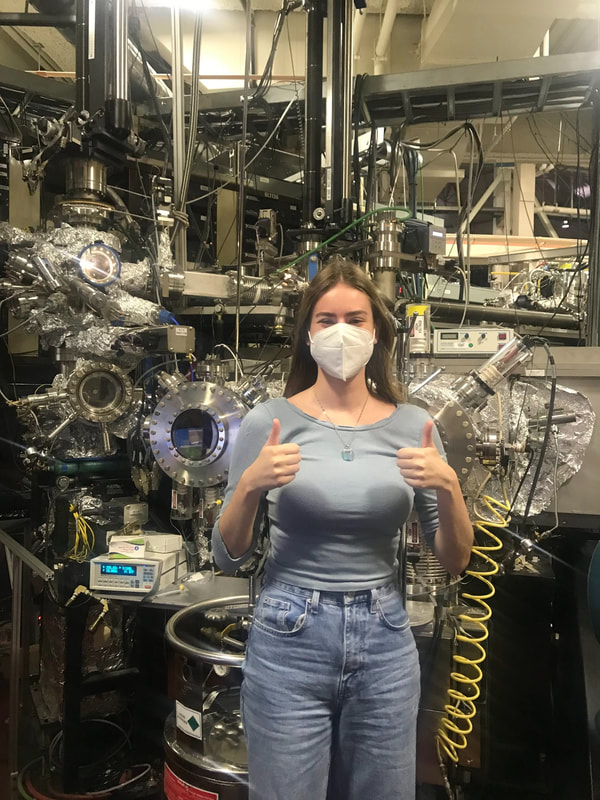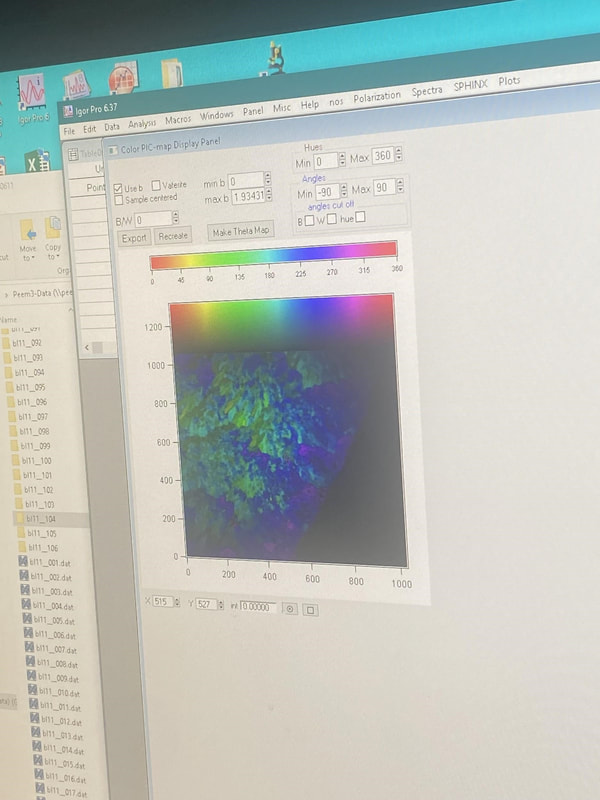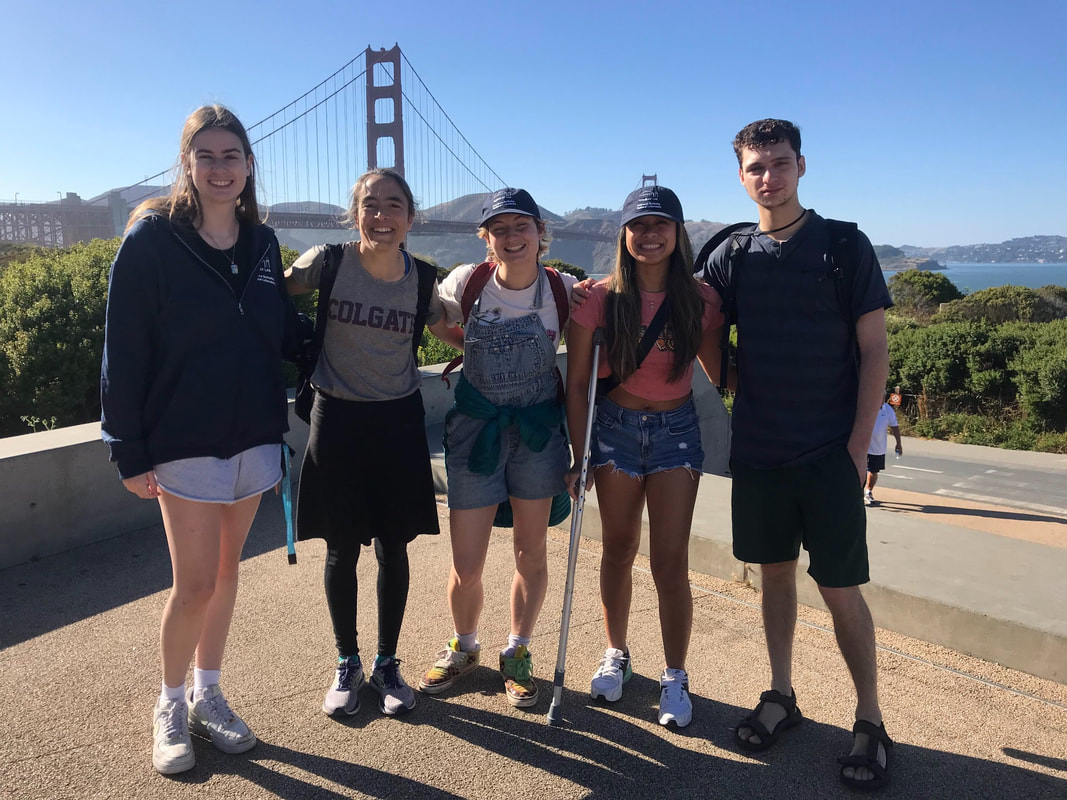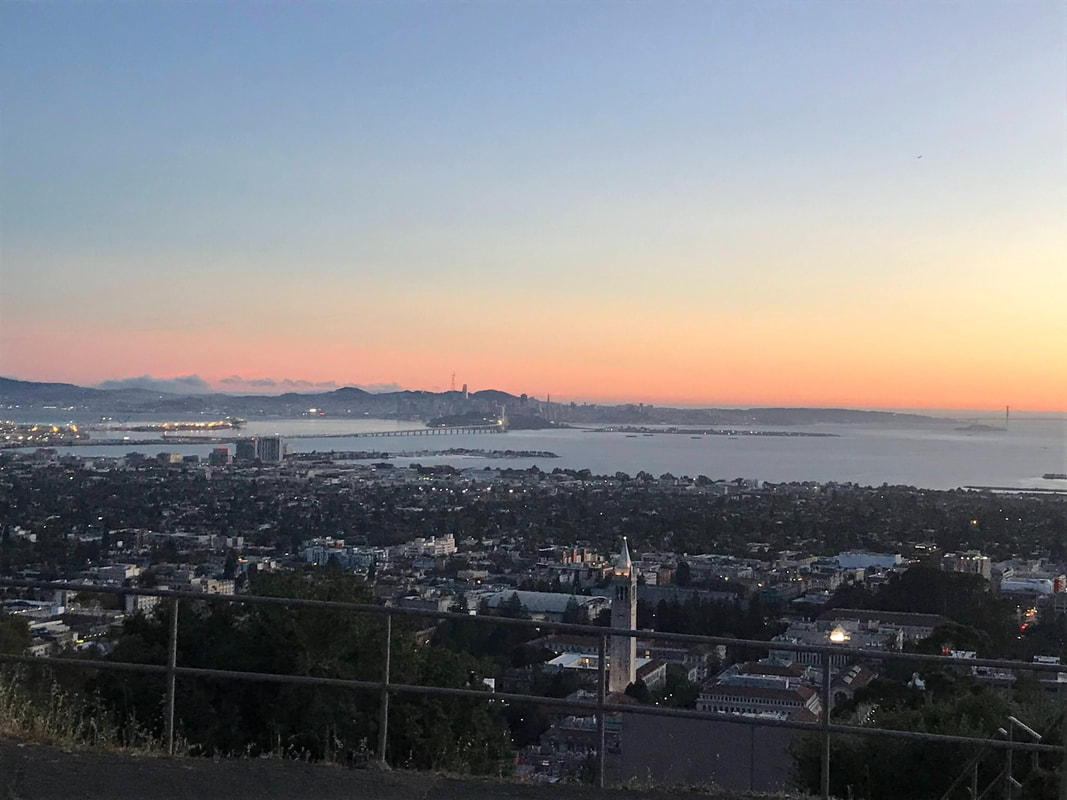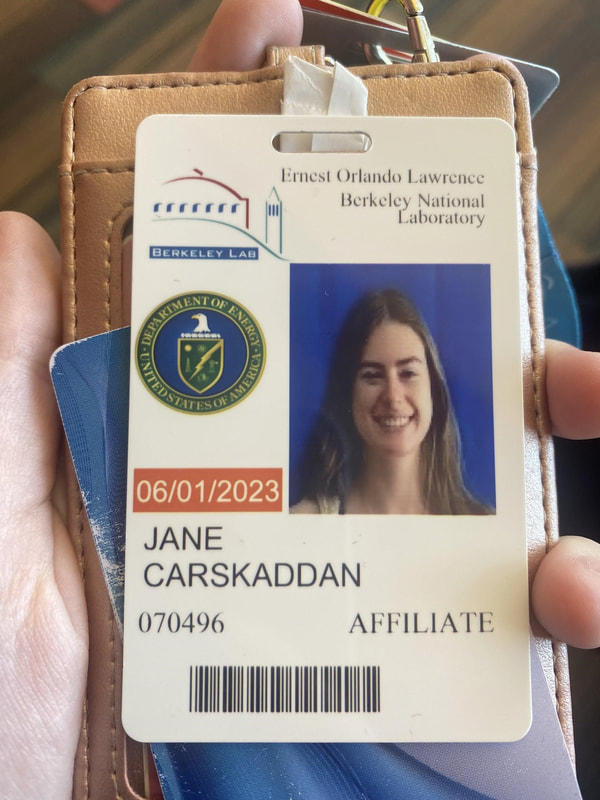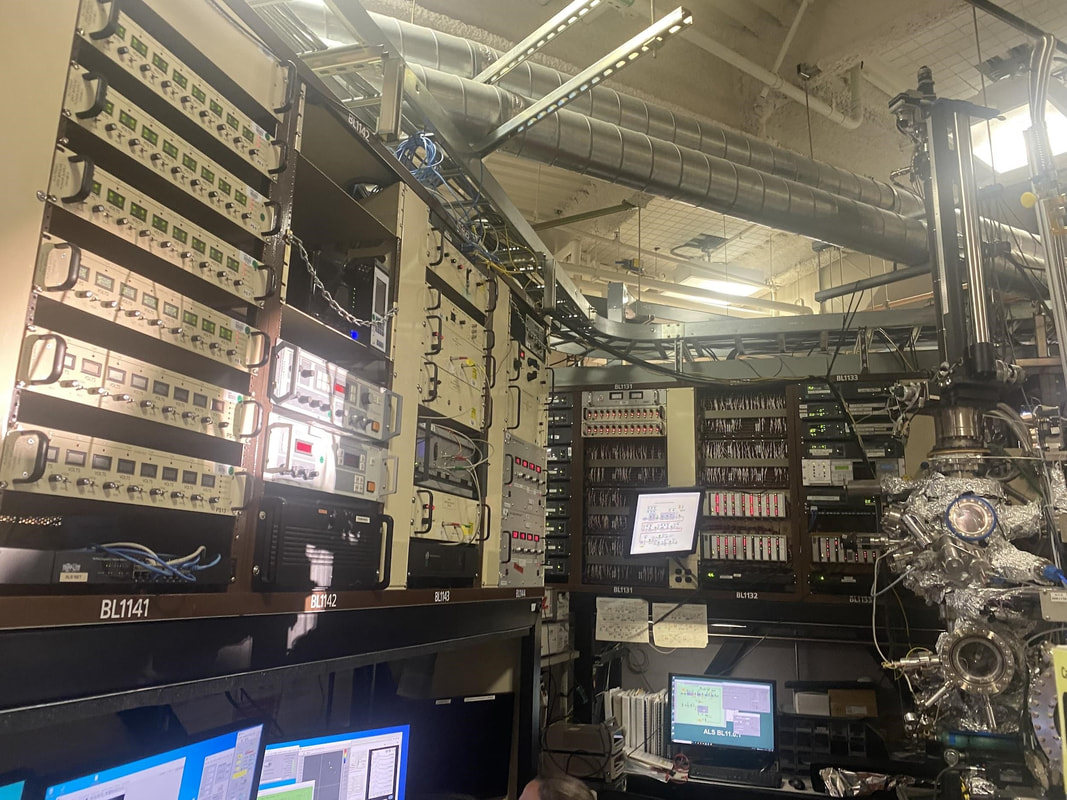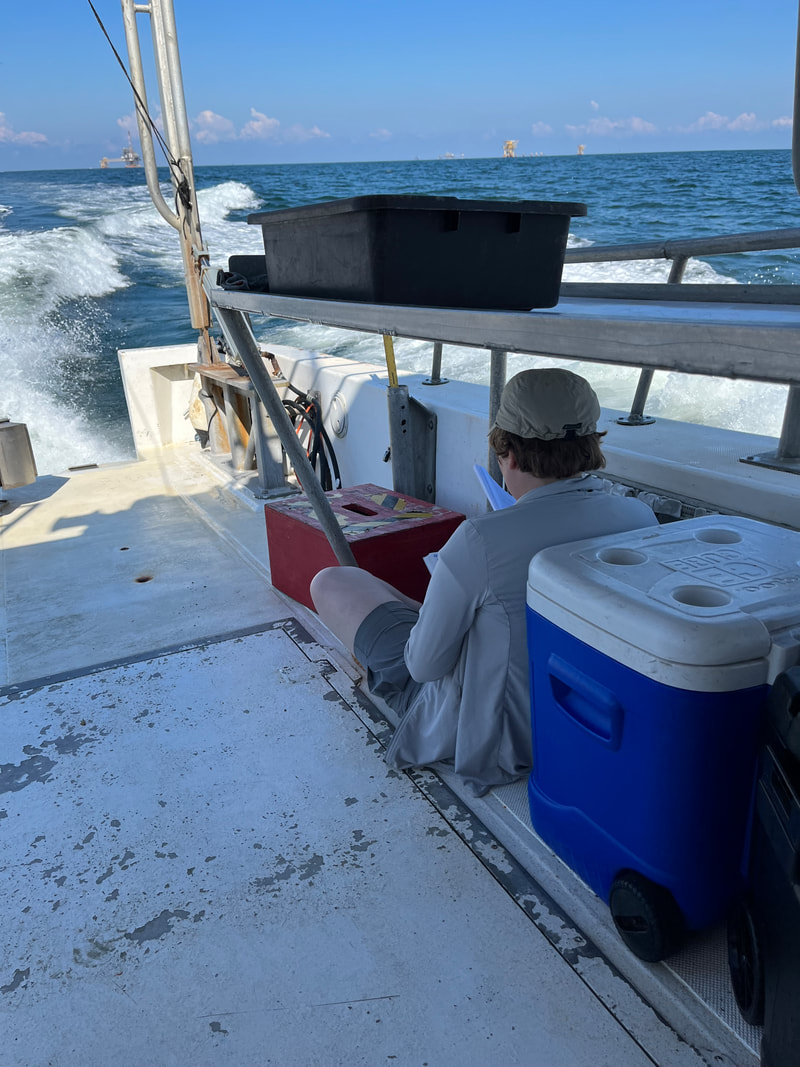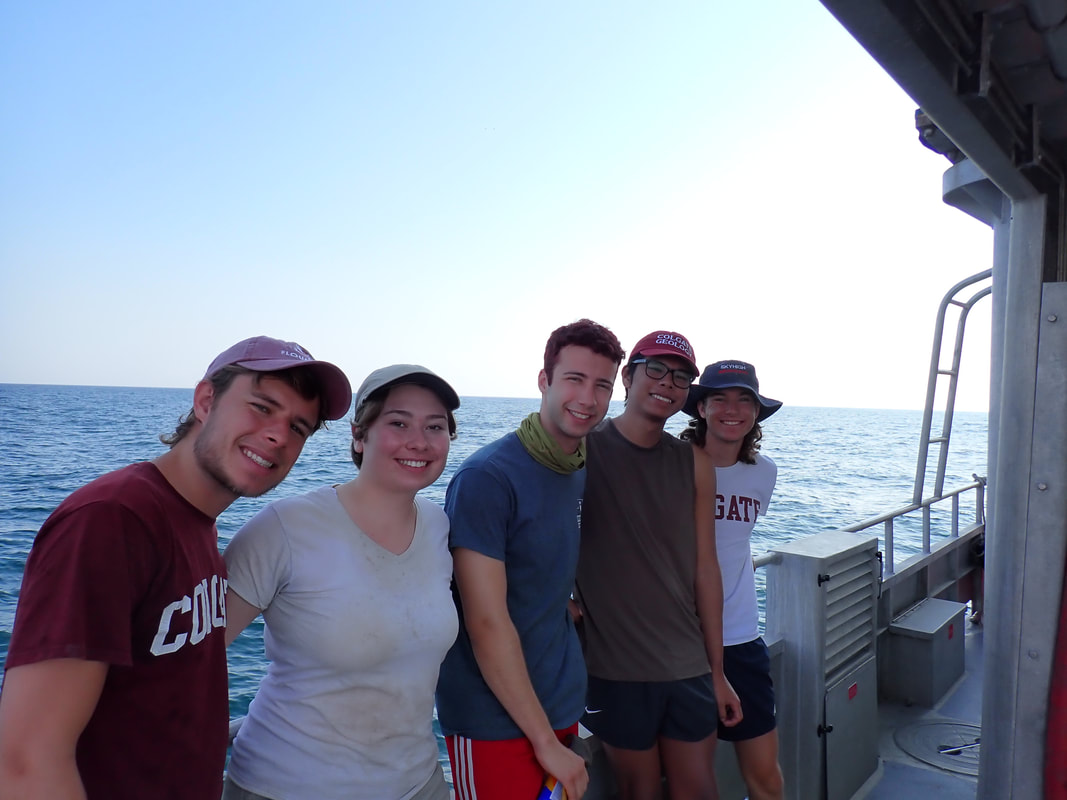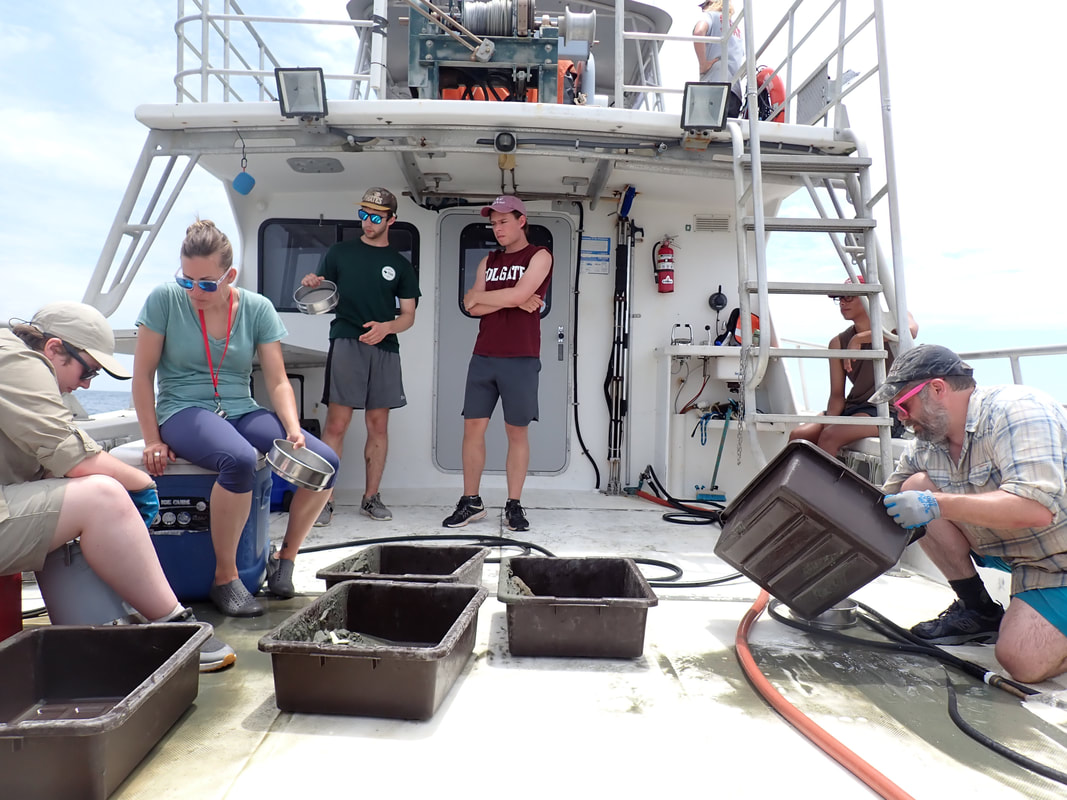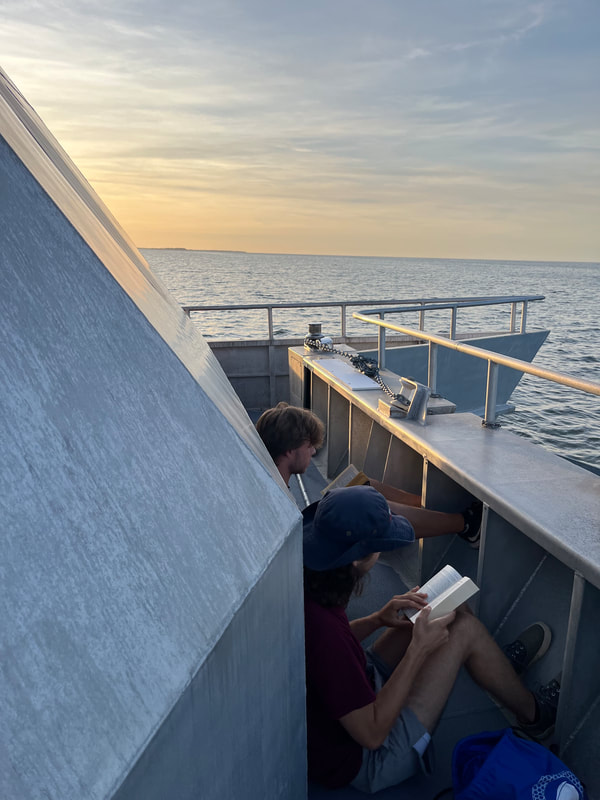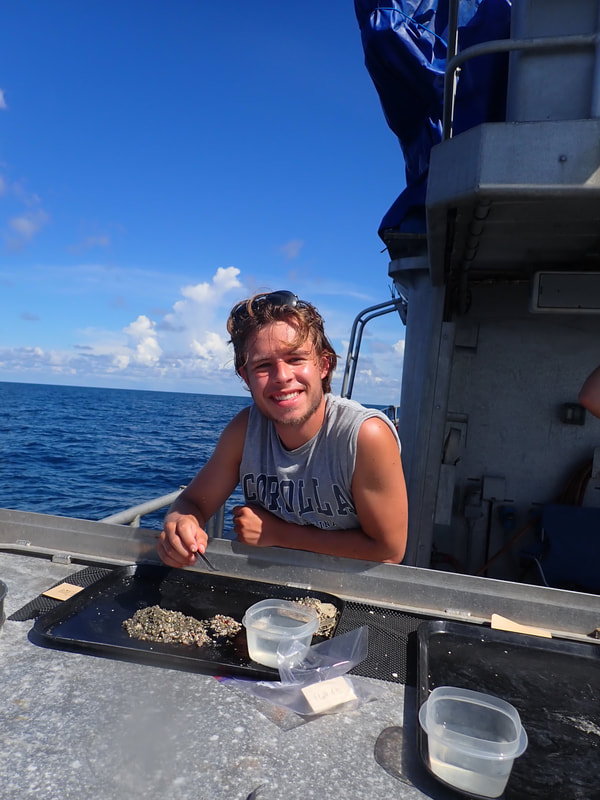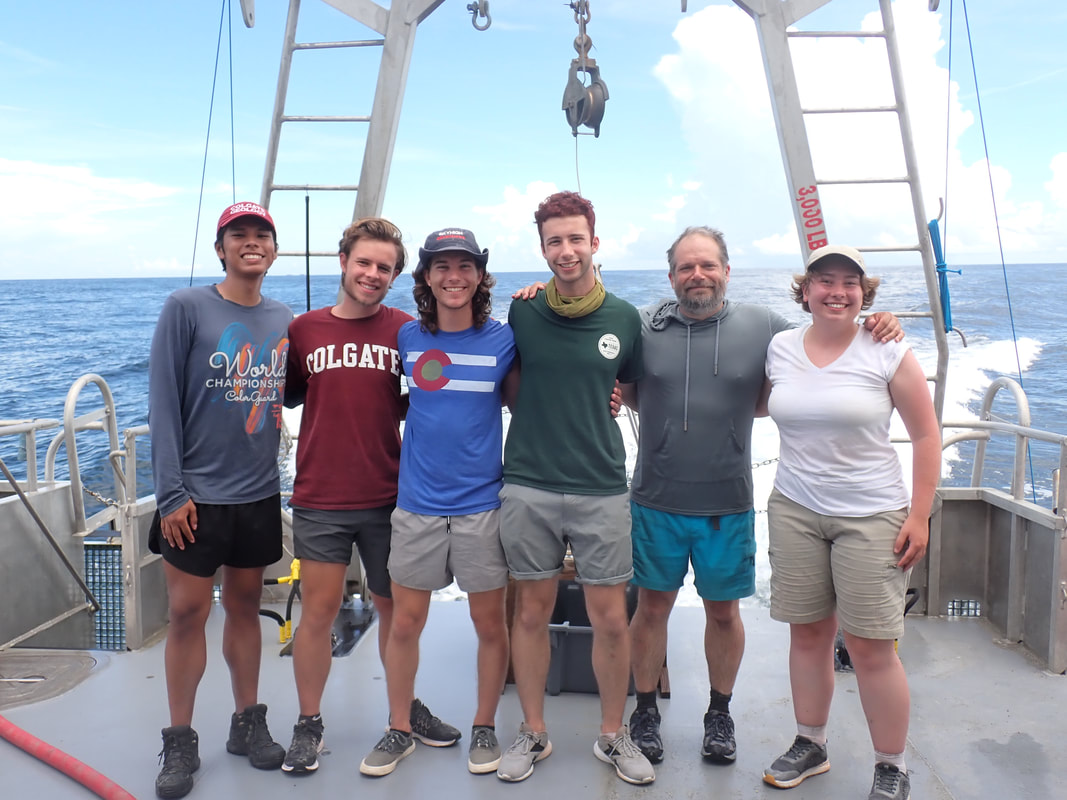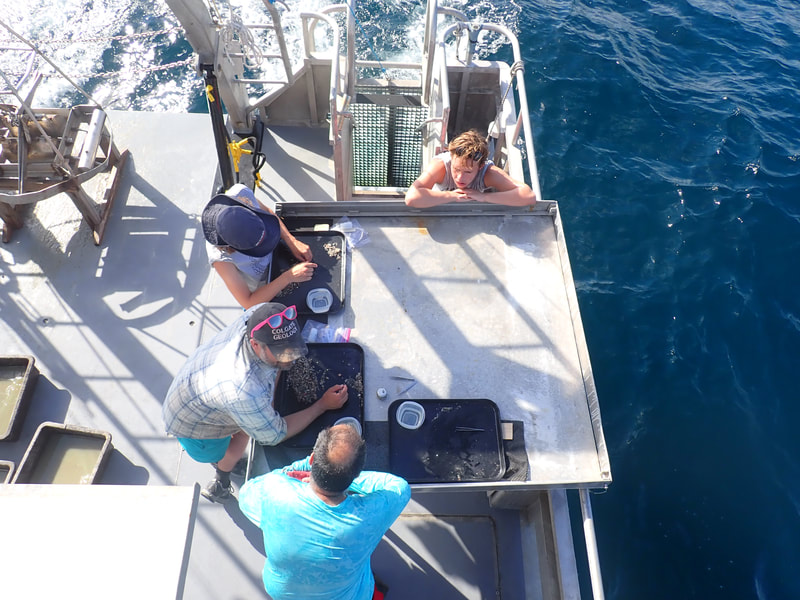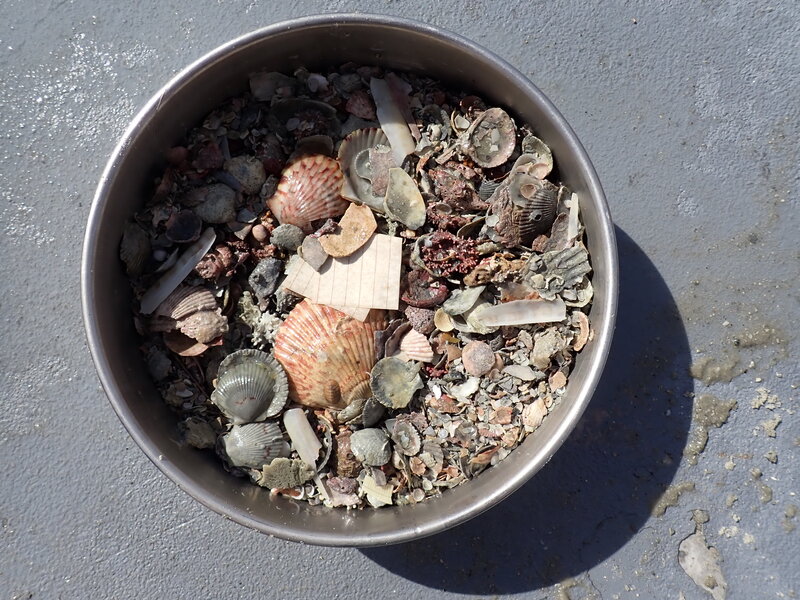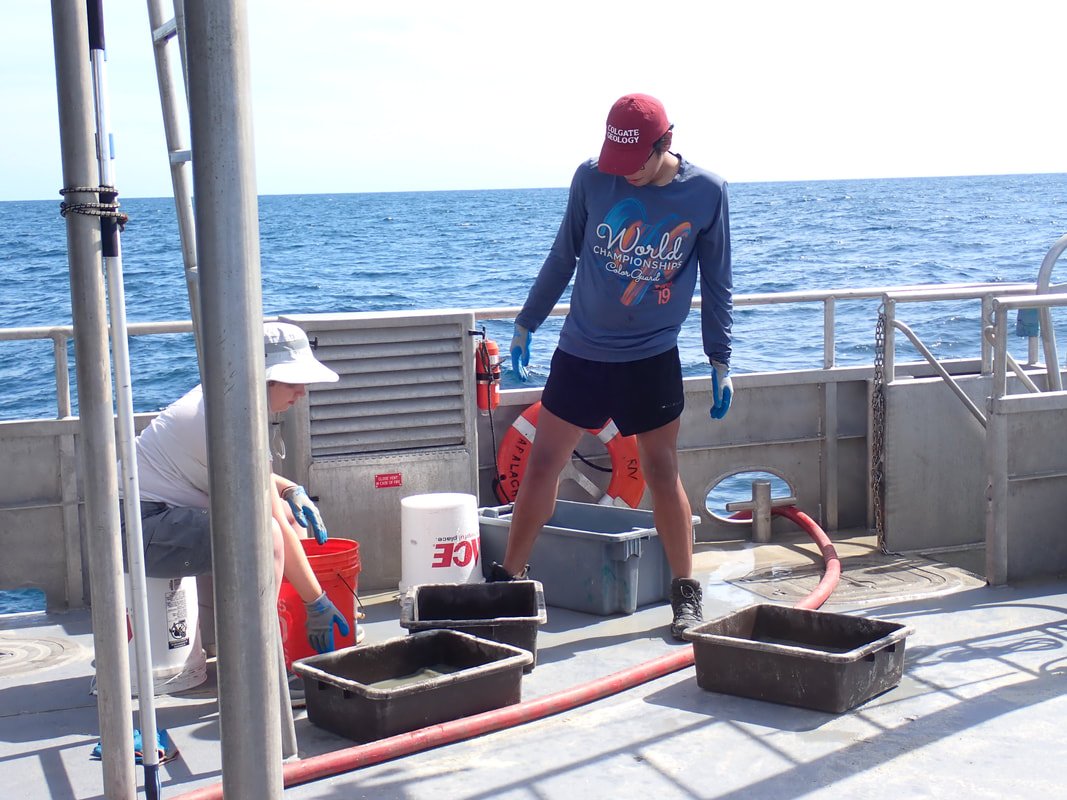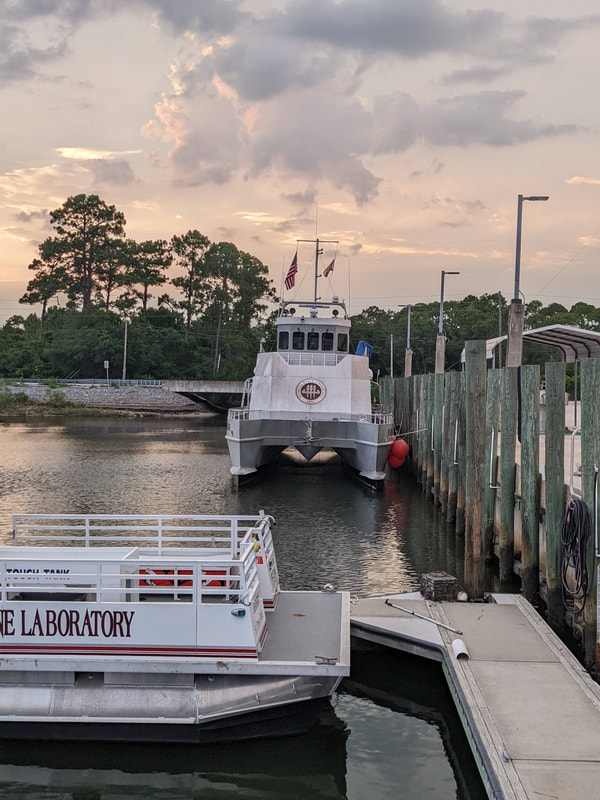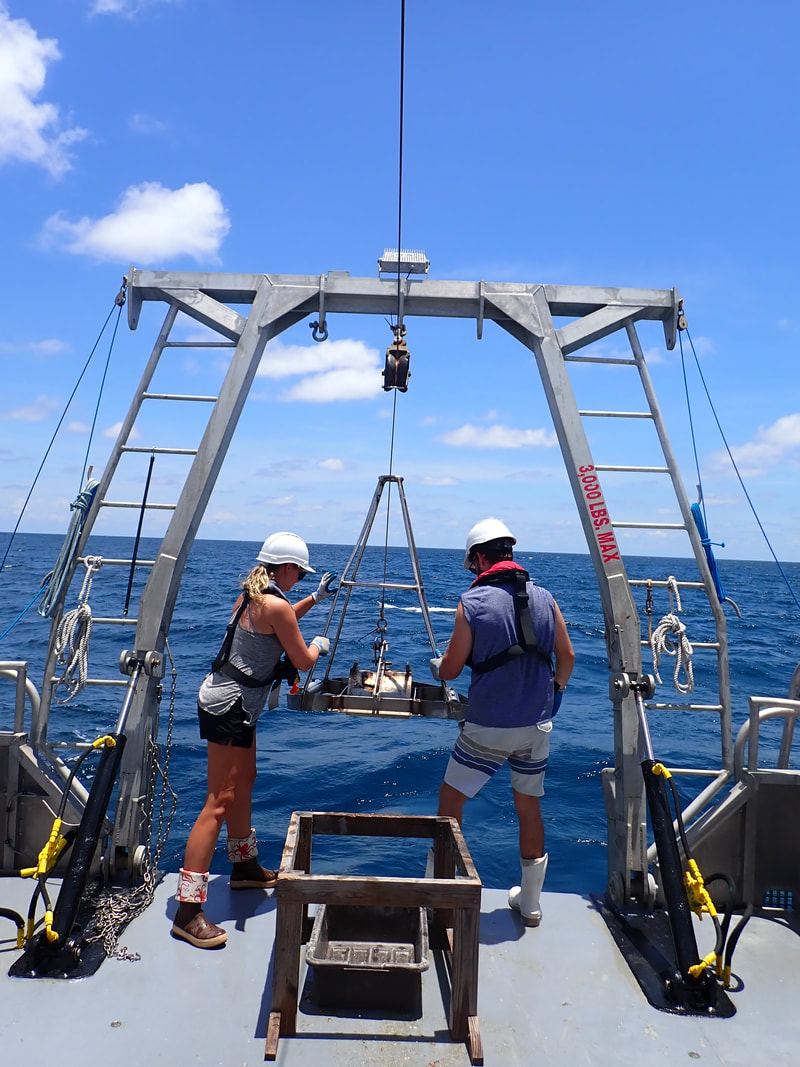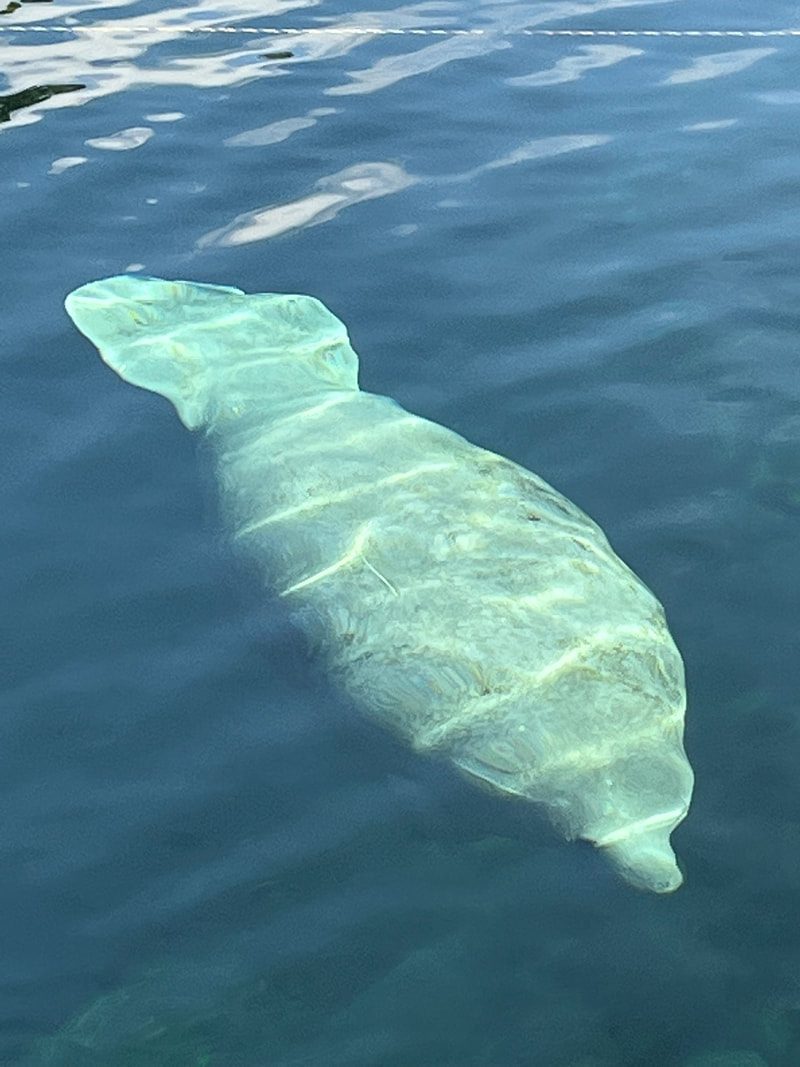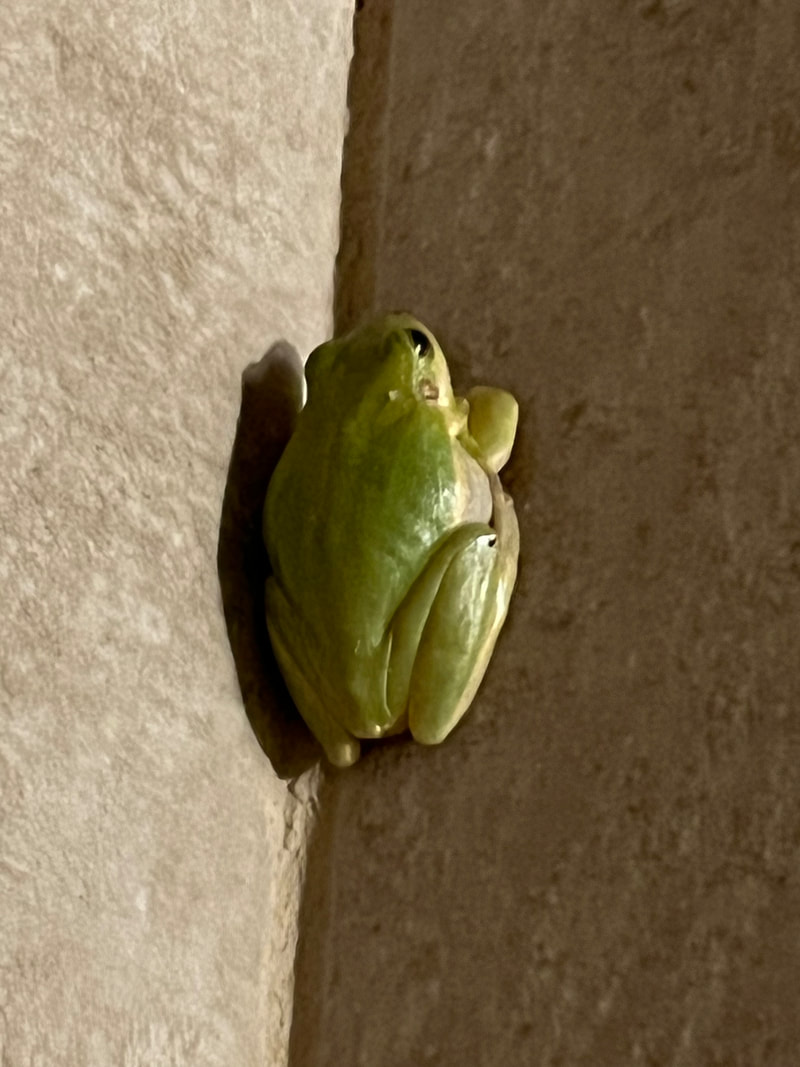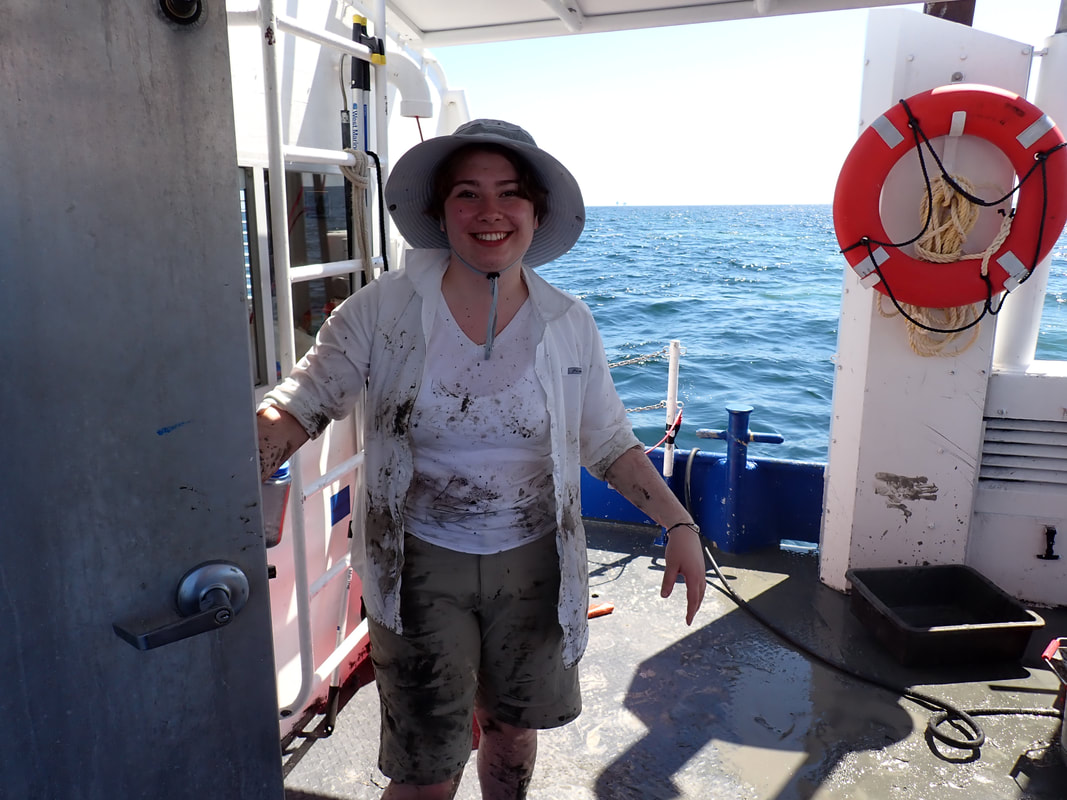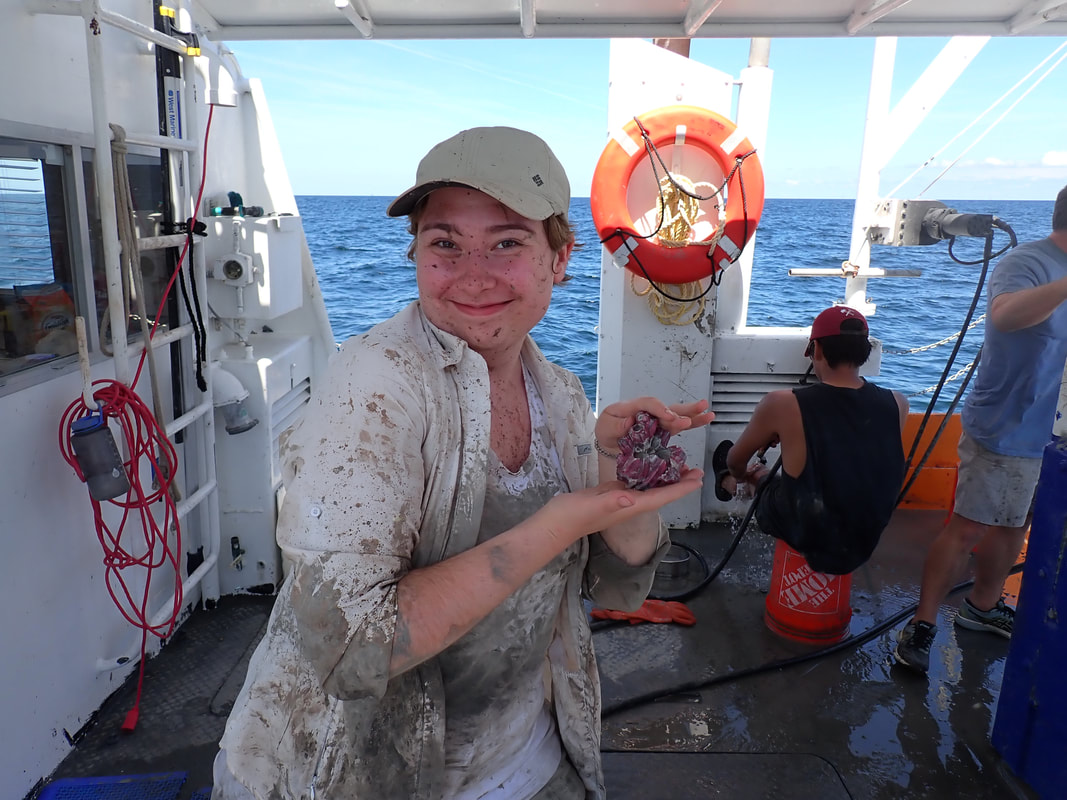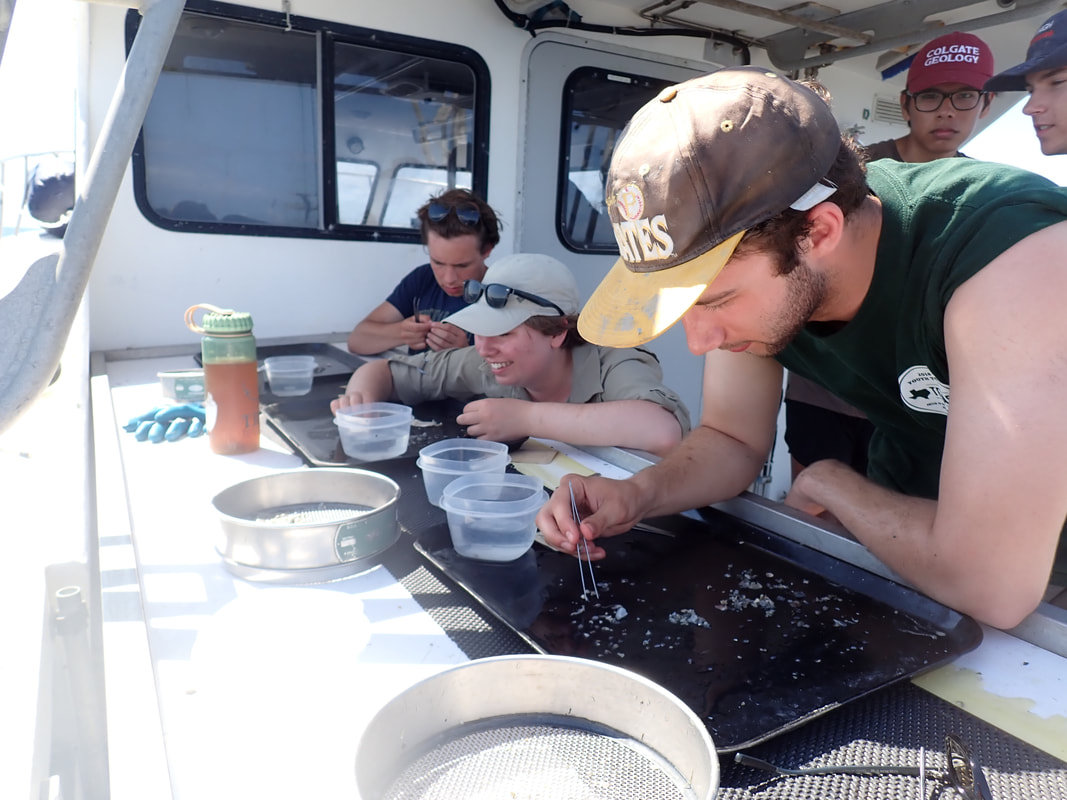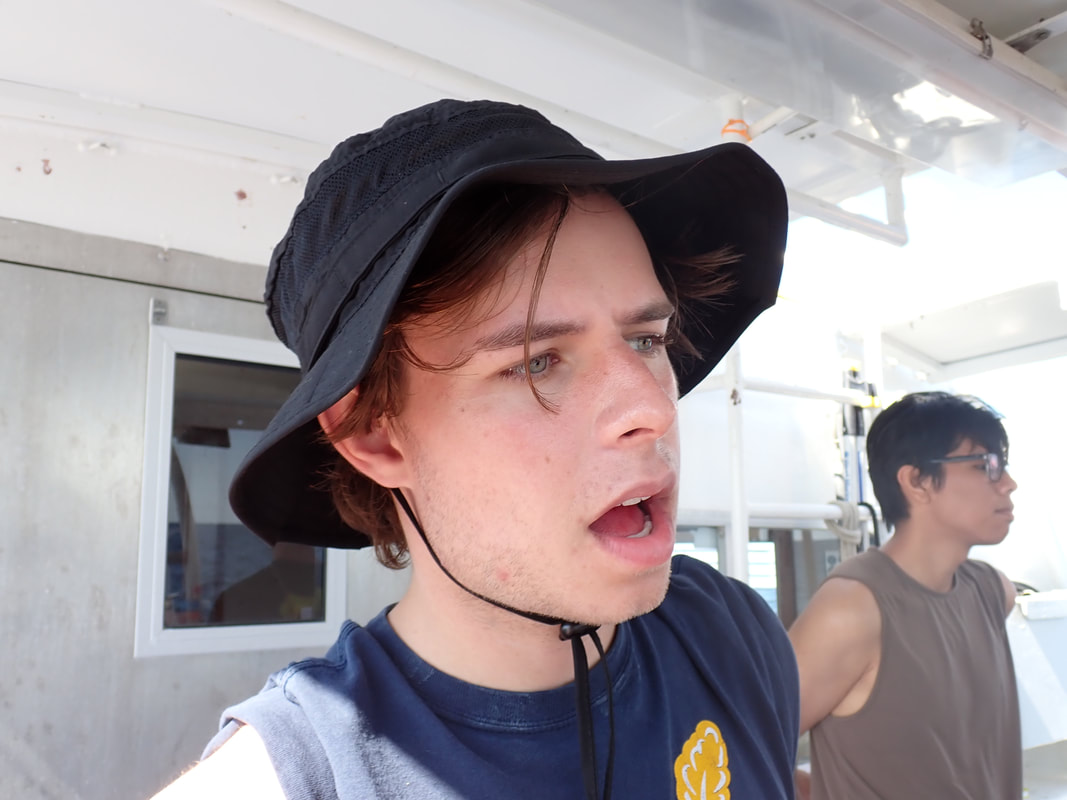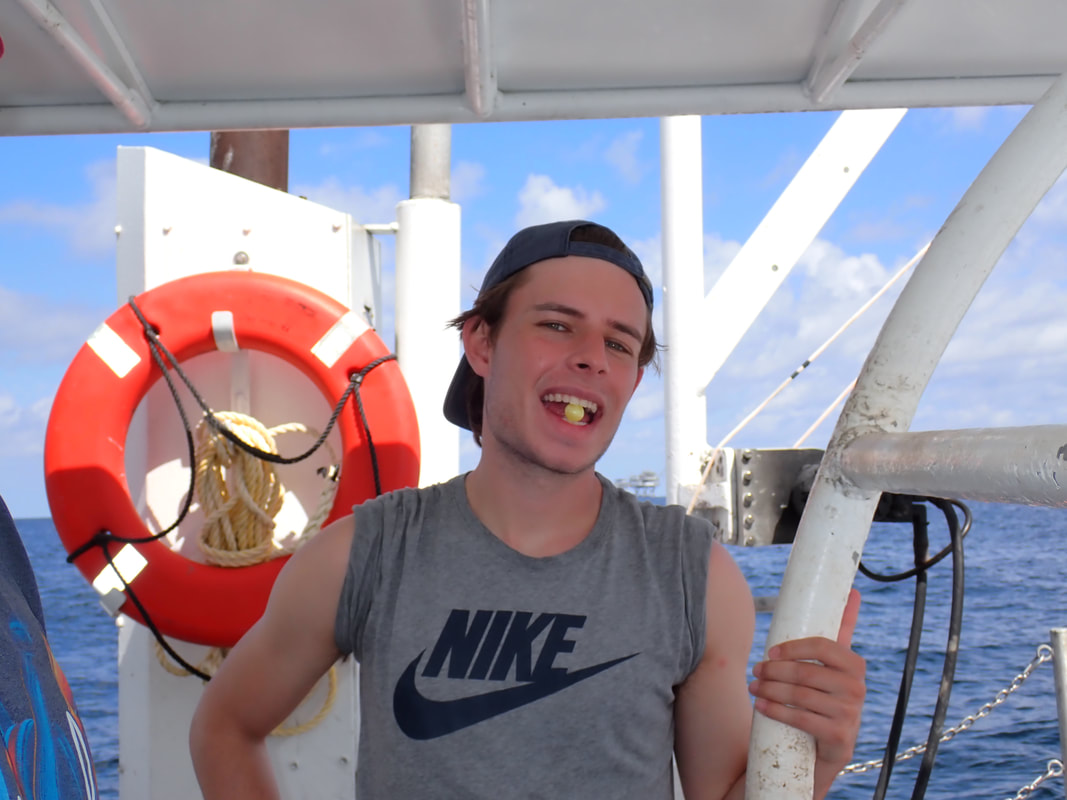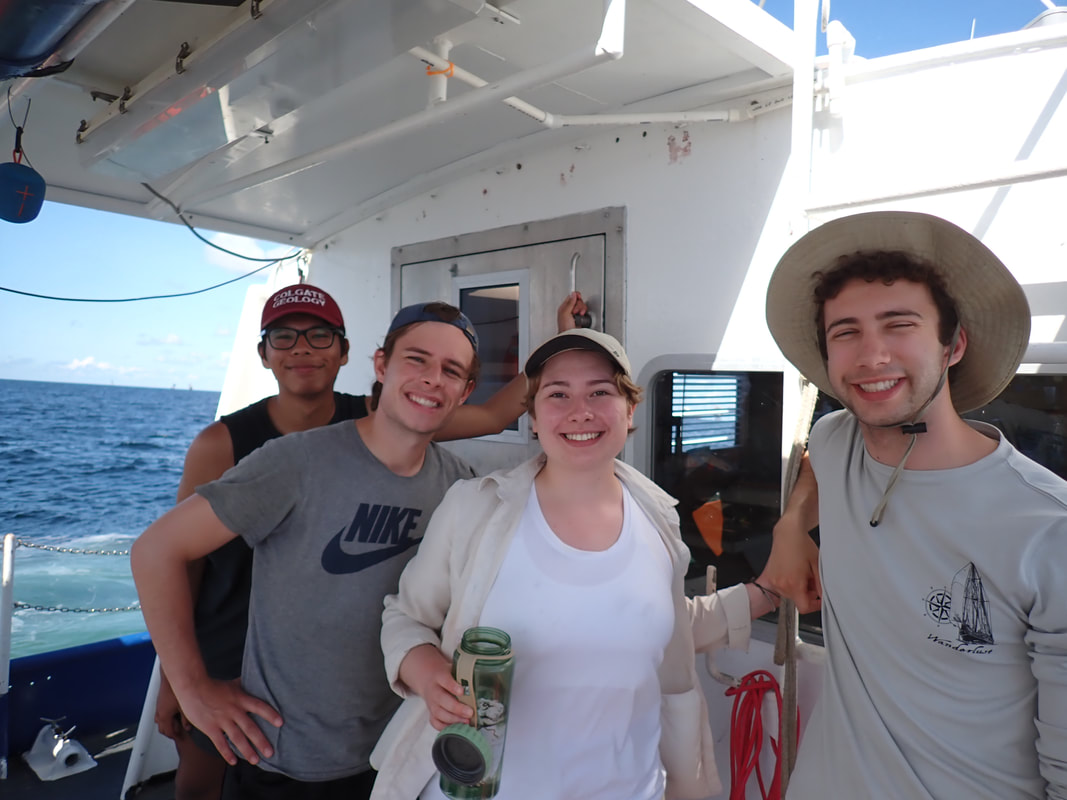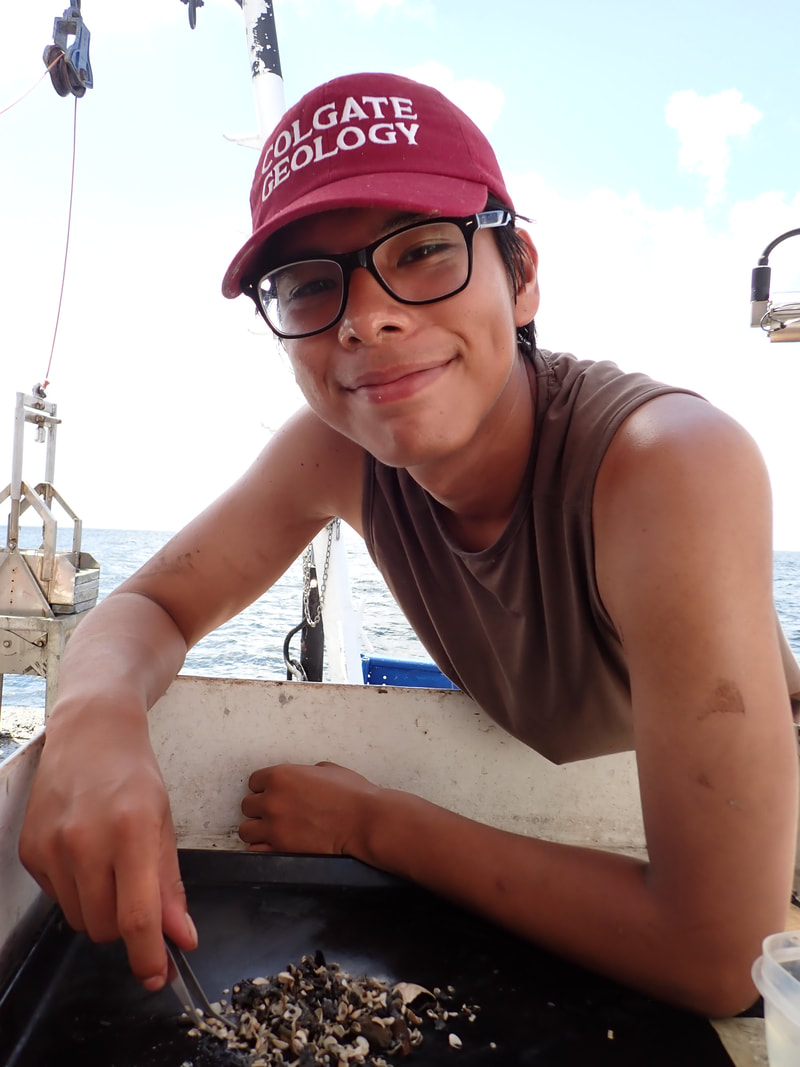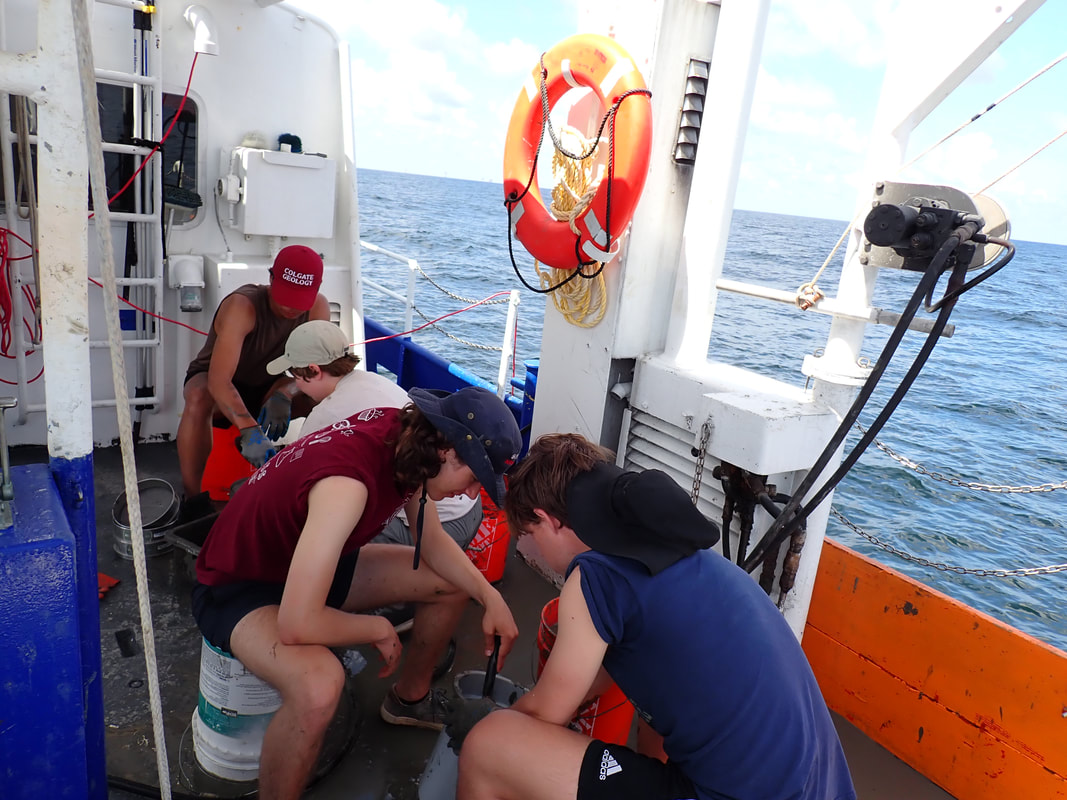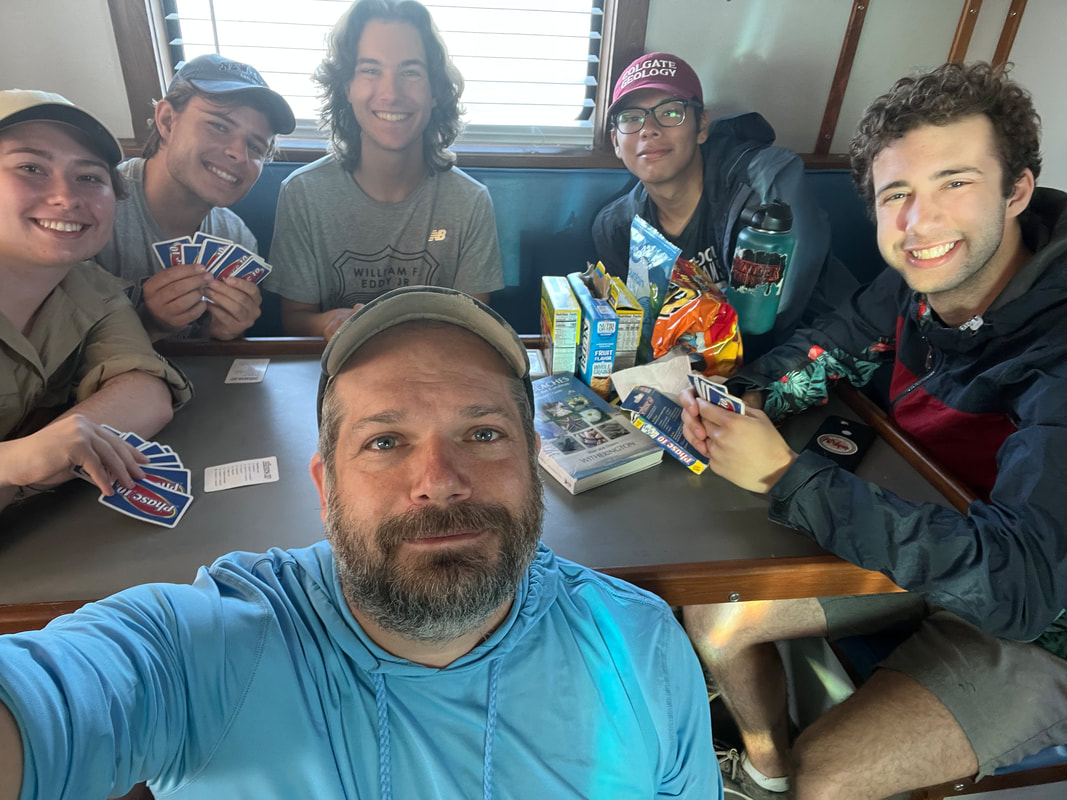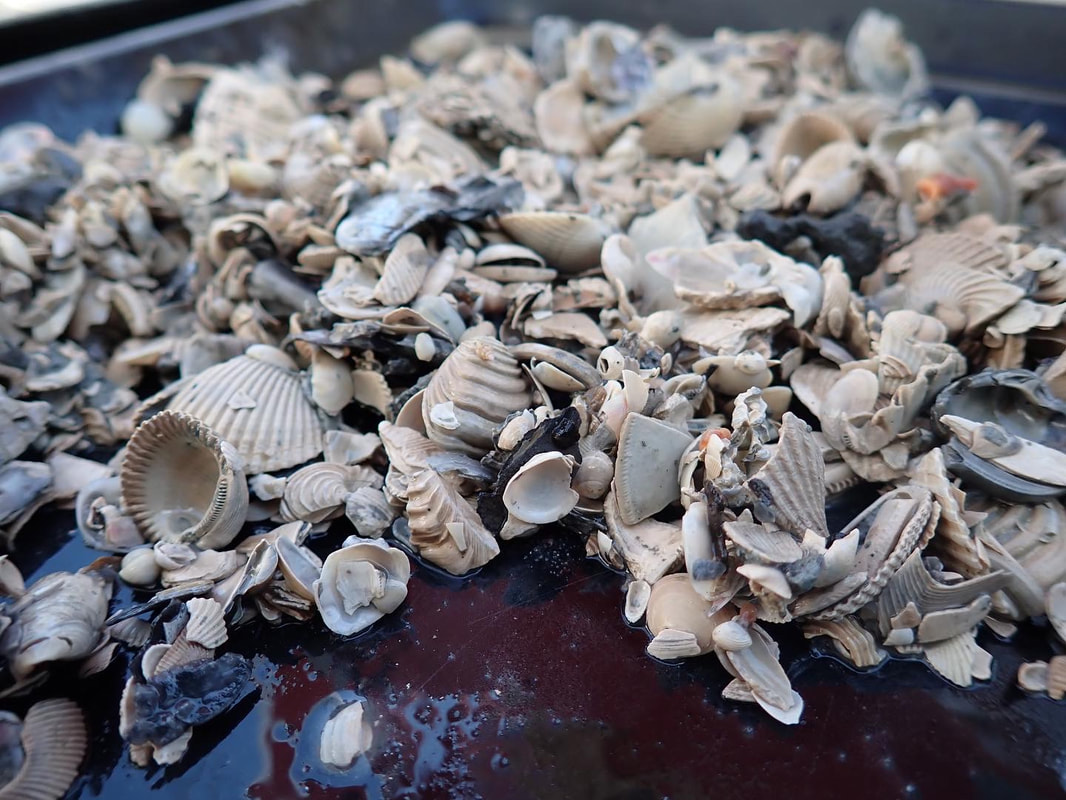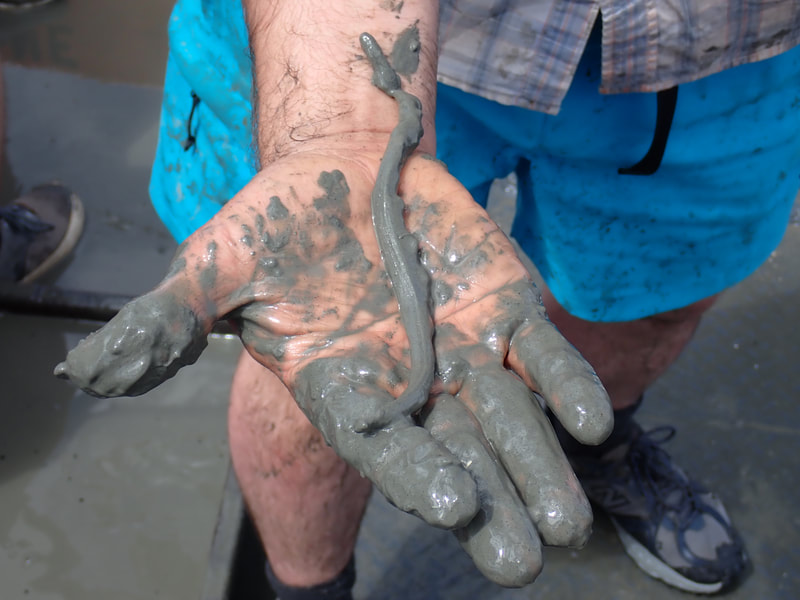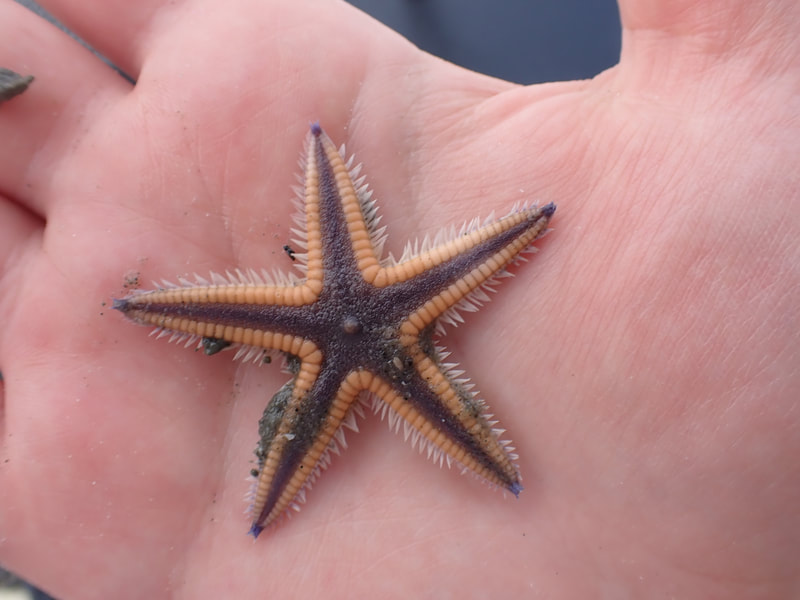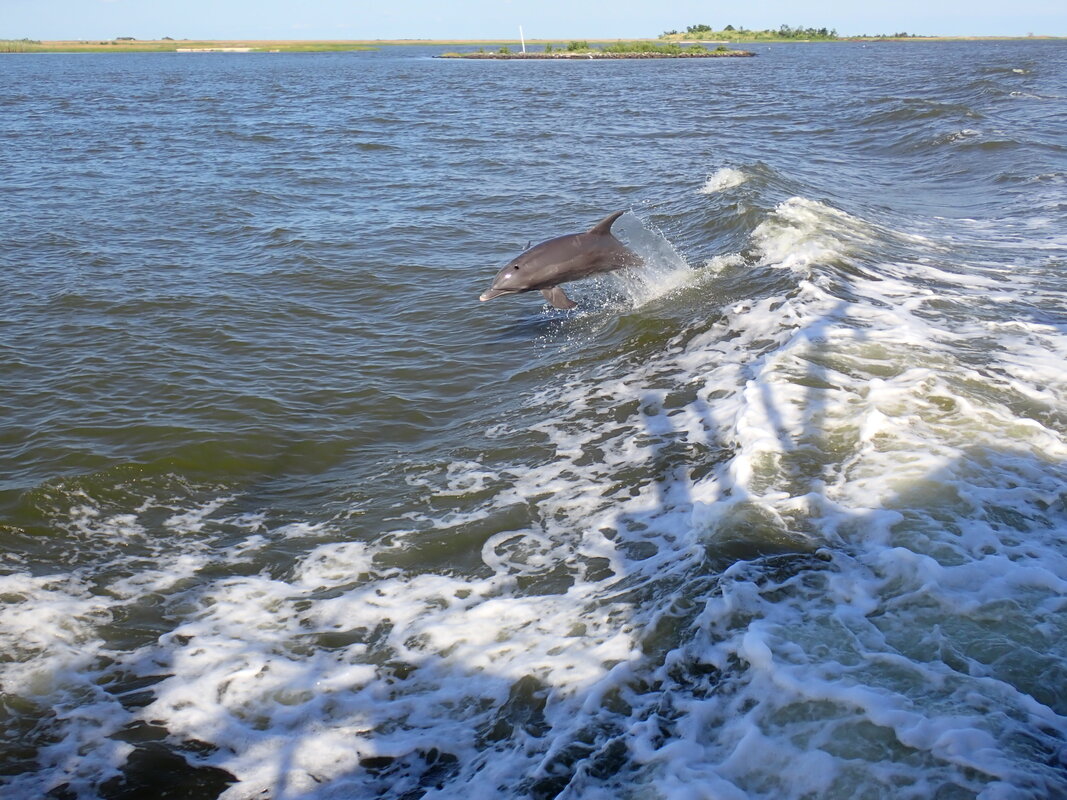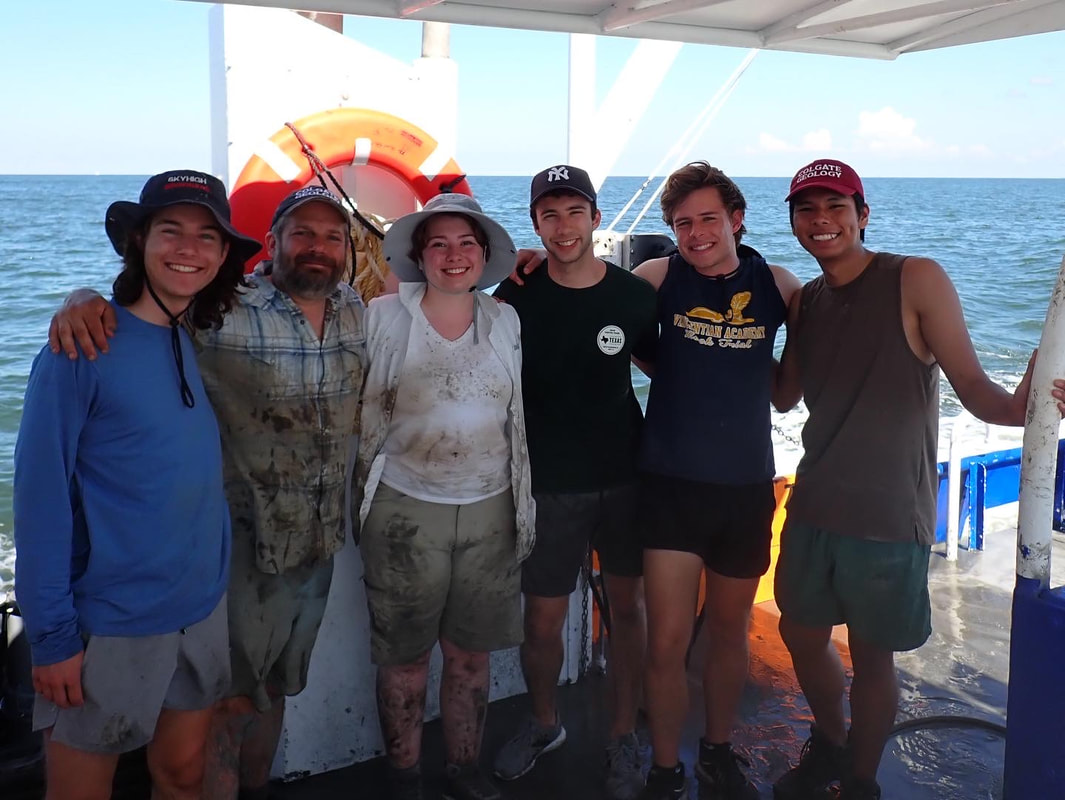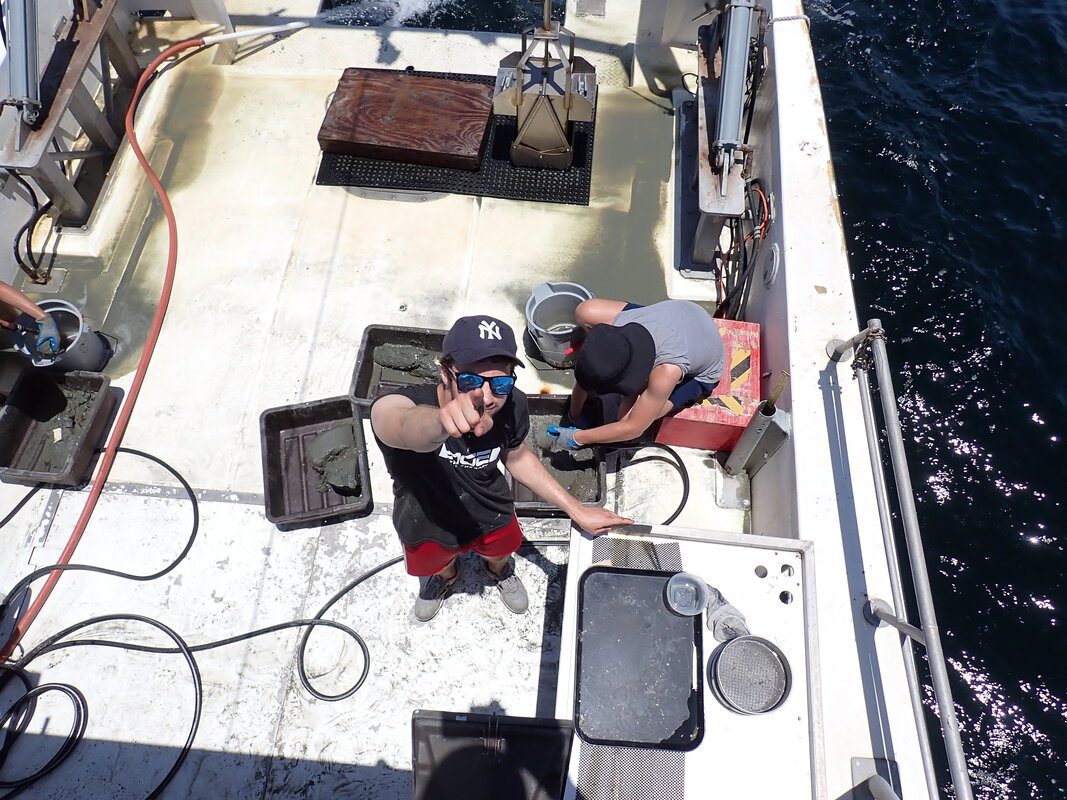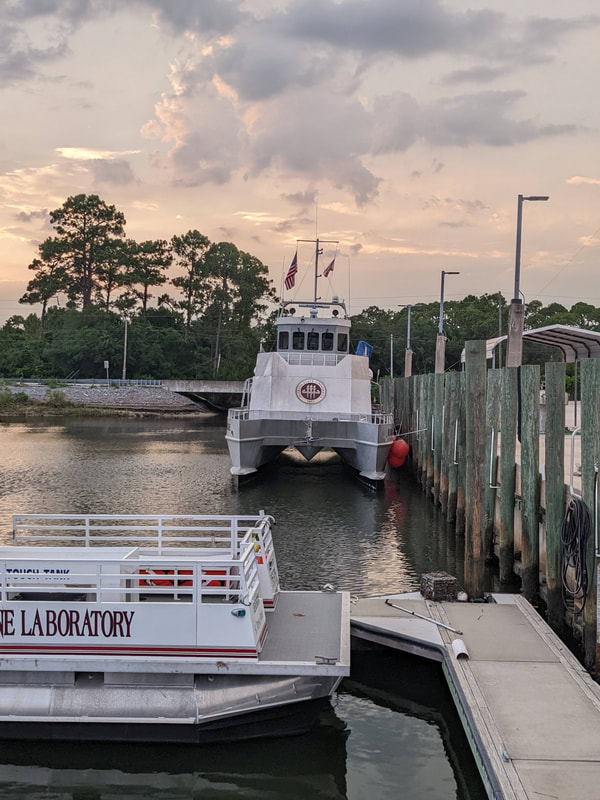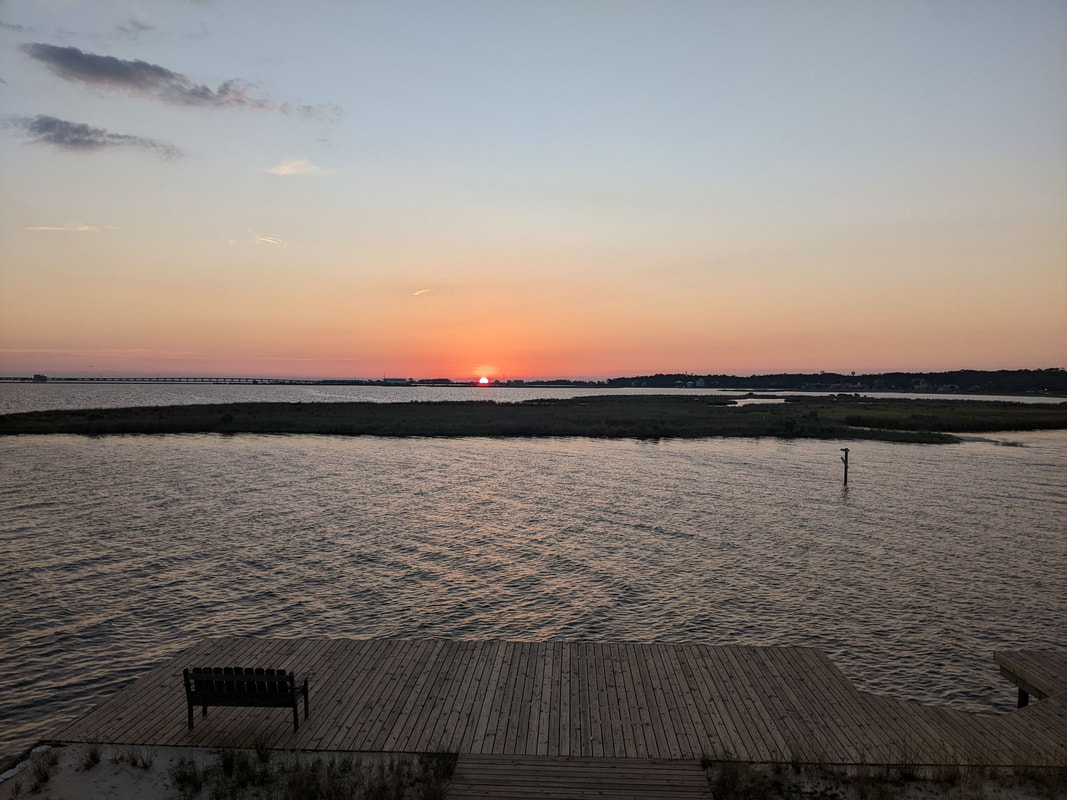|
Post by Jane Carskaddan (Colgate '24).
While Paul and the Gulf team were digging through sediment on their boats, I was back at Colgate hard at work on a different project. Together with biophysics professor Rebecca Metzler, I’ve been looking at the microstructure of shells from Paul’s archives to see if anthropogenic influences have changed the way bivalves grow their shells. My days in the lab aren’t as eventful as the rest of the group’s days in the field, but I still got to do a bit of traveling for my project this summer. I got the opportunity to go to Berkeley, California to gather data on my samples using an X-ray Photoemission Electron Microscope (XPEEM) at Berkeley Labs. An XPEEM is a very powerful microscope powered by a synchrotron, which is a type of particle accelerator. It's used for all sorts of things, but for my project we wanted to look at the different orientations of the crystals that make up my shells. So, Rebecca’s lab set out to California with a freezer of shellfish samples. I spent our free day exploring beautiful San Francisco with two of my labmates, Sarah and Gabe, where we saw sea lions, ate dim sum, and touched the freezing Pacific Ocean (much less welcoming than the Gulf). The next morning at 7 am was the official start of Rebecca’s time on the XPEEM. She had 48 straight hours and we had to make every second count. To tackle those hours, we split into pairs: Sarah and Edlin for the day shifts, me and Gabe for the nights. Rebecca would be up for the entire 48, a fact that made me think twice before complaining too much about my own exhaustion. So, Gabe and I reported to the synchrotron just as the sun was starting to set at 7 pm. You walk into the big pink building and are immediately confronted by huge machines with wires sprawling every which way. It's a little intimidating, but the fact that a lot of the equipment is covered in tin foil (to keep heat in) somewhat took away from that effect. The XPEEM itself doesn’t look like a microscope at all. If you look at the picture of me in front of it, everything behind me is the microscope. The sample sits inside one of the portholes. There’s also a giant wall of controls that was double my height. I only ever saw Rebecca adjust a few of them, so maybe they’re just there for show. Working on the XPEEM is largely uneventful and very slow - you run scans that take ten minutes and run the data through an image generating program that takes twenty. It takes hours to collect enough data for a whole shell. Edlin and Sarah spent their day on one of their samples of barnacles that they hoped would only take their shift to finish. We ended up working on that same sample for most of the night. I won’t lie, seeing how long those barnacles were taking was really frustrating to me. By the middle of the night I was so tired and just wanted to see the images of my shells. We finally got my first shells loaded somewhere around 5 am and produced a few images by the time my shift was over at 7 am. I was so excited after waiting all night that I almost wanted to stay longer and keep working, but my need for sleep outweighed that desire (by the time I got to bed I had been awake for almost 24 hours). The second night was more of the same, except this time I was well rested from sleeping all day and actually got to work on my shells for most of the night. We left California the next day after seeing the Golden Gate Bridge and took a few days to reset our sleep schedules. It was an exhausting experience, but for me it was worth it. I love microscopy and this type of data collection. I found myself feeling very comfortable surrounded by gigantic instruments at a particle accelerator in the dead of night. I legitimately hope that I will be able to return one day in some capacity, even if it means consuming a worrying amount of caffeine again. Post by Charlie Filipovich (Colgate '23). Sitting on the deck of the R/V Apalachee, taking in the slightly salty breeze and enjoying the complimentary turbulence, there were two things on my mind: 1) thanking the creators of motion sickness medicine and aggressively spicy snacks, and 2) pondering options of how I can continue to do this after Colgate. As a rising senior, I can see the maroon light at the end of the tunnel, with the looming question of “what’s next?” pushing me ever closer to it. I like to think of my academic journey thus far as its own experiment: much like this summer’s fieldwork, flexibility is required and you never know for certain what you’re going to discover. I knew I wanted to pursue a career in academia after Colgate, perhaps in the form of a PhD or Master’s program, but I wasn’t totally sure if paleobiology was the right field for me or if grad school was something I was truly interested in. With only classroom experience, I needed more data to test my hypothesis. This summer was the perfect opportunity to do so. Something I learned quite quickly is, like the organisms we’re studying, there are times when we need to adapt to our surrounding conditions. Everyday lent something new, from different weather conditions (sometimes preventing us from going offshore), new substrate types that required different methods of sieving samples, or unexpected hiccups. This is the nature of fieldwork, and despite times of uncertainty, I loved every minute of it. In fact, on our downtimes onshore, I began to look at potential grad school programs that are located on the coast, studying the intersections of paleobiology and climate science! Part one of my hypothesis: check! In addition to our fieldwork, we had the pleasure of being joined by faculty of local universities in related fields. While nerding out over our samples, we casually discussed their journeys to grad school and what their recommendations were for a very early career scientist. I really appreciated their advice, and different perspectives, especially having valuable insight into the admissions process and what life is like in a PhD program. Plus, a couple of the professors that joined us took their own samples from our boxcores, which goes to show all of the different avenues one can study from a similar sampling procedure. I feel much more confident in reaching out to potential advisers and the “do’s and don'ts” of applications. Part two of my hypothesis: check! Overall, this summer has been really influential on my plans for the future and I am excited to begin the analysis phase of our research!
Post by Luke Calderaro (Colgate '22). Work days in Louisiana and Alabama were tough. Our days at sea were long, the Sun was a bright yet haunting constant, and our two boats sometimes felt extremely crowded. At the end of the first leg of our experience, I was looking forward to a bit of time on land. Not long after arriving in Hamilton, though, an unexpected eagerness to get back on the water overcame me. Given our time in Cocodrie and on Dauphin Island, I thought I was fully prepared for our time in Florida. Little did I know that the Sunshine State had a lot in store for us. I have been playing soccer competitively and leisurely for almost eighteen years at this point, and I think I sweat more in one day on the boat than in any single soccer game in my life. Our first day at sea in Florida was intense. The temperature in direct sunlight was sometimes greater than 100°F, and the sediment samples were enormous. Drinking plenty of water was a necessity, and Paul made sure to keep us on track. I stepped on to land that evening and was so exhausted that I fell asleep around 10 PM. My hopes of evenly spread workdays were crushed when two days of bad weather meant that our team would be at sea for four days straight. I knew from that moment that each day would have to be a strategic mix of work and breaks to conserve energy throughout the week. Despite the heat and sun, our entire team made it through the week and back to Hamilton. Looking back on the Florida experience, I have not experienced that level of exhaustion in quite some time; I can definitely see why fieldwork is not for everyone. I now have a sort of appreciation for that kind of physical exhaustion, though. It is different from anything that I went through during my undergraduate career, which was filled with a lot of mental and emotional exhaustion. Would I do it all again? Absolutely! For the first time, my job did not feel like a “job.” The joy of being out on the water and collecting specimens that had never been seen before made time fly. On our last day when Paul mentioned that this could be our last time at sea, I thought to myself, that for me,this was definitely not going to be my last time on the ocean.
Post by Juan José Gómez (Colgate '24). While in the Gulf this summer, the heat and humidity were not the only things by our side as we did fieldwork. Our lab group was fortunate enough to meet researchers in adjacent fields, as they joined us on some of our offshore days. Meeting local people, as well as taking time to explore the areas of Alabama, Florida, and Louisiana where we were based, exposed us to various cultures of the South (some aspects which were more discreet than others). We were also able to insert ourselves into the extremely fun world of marine research at the Florida State University Coastal and Marine Lab (FSUCML), Louisiana Universities Marine Consortium (LUMCON), and the Dauphin Island Sea Lab (DISL). With every boat ride, came friendly faces which became voices of guidance as we talked about careers. Our conversations with people ranged from graduate students to tenured professors. Even while working in the blistering heat, we talked about preparation for graduate school applications and our futures beyond our academic careers. Most of these informal encounters happened on the boat as the seas rocked us back and forth, during dinner on outdoor swings, and in spaces at the marine labs. Some employees of the marine labs shared their journeys that brought them to where they are currently. These stories were made much more real by disclosing the mistakes that we can expect along the way. I enjoyed the conversations that we had and found them to be very influential in thinking about what I might do following my experience learning about marine invertebrates. There was never a dull moment when participating in fieldwork; most times I thought about how the work seemed more fun than I expected. We shared many laughs on the boat, and after hearing so much about other people's experiences, I feel more confident than ever in my decision to take a few years in between undergraduate and graduate studies to establish an adult life beyond the classroom. This research experience has also furthered my interests in becoming an environmentalist, solely because I was immersed in a community passionate about learning about our changing planet. The process of observing past environments is intriguing nonetheless and can be helpful in understanding modern changes. In continuing to pursue a path focused on understanding environmental change, I hope I will get to be as comfortable as I was this summer doing fieldwork in the Gulf of Mexico.
Post by Victor Unnone (Colgate '23). Wherever we traveled seemed to bring a set of experiences that I felt was unique to each state. That being said, Florida brought me some of the most memorable experiences during our fieldwork. As I approached the R/V Apalachee, the first thought that entered my mind was how similar it was to a battleship. Its aluminum body glinted under the beating sun, blinding me when I stared directly at it and searing my palm as I touched it. The catamaran-style frame came to two points at the bow, which centered the logo of Florida State University that looked suspiciously like Colgate’s. This vessel came to be my favorite of the three that we worked on this summer, and the crew we worked with were a major contributor to this. My future was on my mind for the majority of the trip, and being among academics meant grad school was the number one discussed topic. The ship techs talked to us about their paths in between sediment grabs, and while I came out of it still unsure of what I wanted to do with my life, they set me with pathways and checkpoints, emphasizing that your career path doesn’t have to be linear. It gave me peace of mind and allowed me to focus on picking through the gravelly shell piles. On our time off, we were able to explore the beauty of Florida, and to experience this we didn’t have to stray further than our back doorstep. We were right on the water at the FSU Marine Lab dorms, and we were treated to some spectacular sunsets and evening thunderstorms. We visited Wakulla Springs State Park on a day that we had rough seas, and I was treated to an incredible view of grazing manatees in crystal clear waters. Luckily, I had my GoPro with me and recruited a nearby swimmer to take an underwater video. Overall, the fieldwork was the perfect way to spend part of my summer. Yes, it felt like we were in a sauna whenever we stepped outside and yes, we woke up at 5:45 am every boat day. Yet, I gained more skills, saw things I never thought I would, and established connections for my future. We also had a frog friend in our shower.
Post by Charlie Filipovich (Colgate '23). Stepping on board the R/V Acadiana is when it finally hit me: “wow, we are actually doing this!” After months of planning and preparation, we were finally here, dressed like extras from Jurassic Park, ready to take on the dense, clay mud of the continental shelf. Much like most of my teammates, the only fieldwork experience I had prior to this moment was from various laboratory courses at Colgate. With the Age of Grad School Applications quickly approaching, this exciting opportunity would allow me to become more confident in what areas I would like to further pursue and better understand what it is like to be truly immersed in the field of paleobiology. And oh was I immersed… in mud… lots of mud. And I loved every minute of it. Our first day offshore began bright and early at 07:00 on our third full day in Louisiana (we had to adapt our plans slightly due to “uncomfortable” weather conditions). We embarked on a somewhat bouncy hour and a half tour to our first location (LA 23) where we learned about the different stations of sample collection: boxcoring, sieving, sorting, and labeling. The sample is initially collected by the boxcore, a device which scoops up the top layer of the sediment (and shells!) on the seafloor. Sieving was the next step, as it is essentially power washing the silt and clay off of the specimens so we could examine them. Sorting was taking said specimens and separating the live clams from the dead shells (and gently throwing the other live critters we don’t study overboard!). Labeling was making separate specimen bags / vials for live samples and the death assemblage. And of course we had to photo document everything! Our offshore days in LA tended to follow the same routine, but each site had its own unique attributes. Some had dense clay which made sieving a bit more laborious, and one in particular had a considerable amount of oyster shell fragments, which we think are relics of the last glacial maximum. Something of interest to me was seeing the differences in live clam types between each location, especially compared to the ones we found in Alabama (more to come on that!). Everyday was a new adventure, and I am looking forward to learning more in the lab about what we found!
Post by Luke Calderaro (Colgate '22). Prior to this trip to the Gulf of Mexico with the PaleoLab, I had little to no field experience. The laboratory activities and demonstrations I completed during my undergraduate career could only prepare me so much for work outside of the classroom. As someone who only recently accepted his intentions to pursue an advanced degree in the Earth sciences, my lack of experience often left me wondering if I was ready to launch into a PhD project that required fieldwork. I felt nothing but excitement when imaging days in the field, but a question kept nagging at my mind: Am I cut out for data collection outside of the lab? After completing the Louisiana and Alabama legs of our Gulf of Mexico excursion, I have gained new confidence in my graduate school preparedness. One of my favorite aspects of the scientific method is the unpredictability of one’s results. Yes, a review of previous related research is required, and yes, hypotheses naturally flow from this reading, but the results of a novel project are never realized until the work is complete. Flexibility is vital for this journey to completion. I learned this during my senior thesis, and found the same need for this skill in our field research. Every day on the water brought new environmental conditions, new surprises, and new challenges that had to be dealt with in order to complete our goals. For example, rough seas often kept us onshore, and at one point, a rare equipment malfunction forced us to return to land for a couple hours to repair gear. In all of these instances, we were forced to adapt, whether that meant shuffling our work schedule to beat poor weather forecasts or sampling multiple sites in a single day. Whatever roadblock got in our way, we were able to shift our plans in order to meet our goals. Embracing flexibility could be a source of conflict for some individuals because, in a way, coming to terms with the need for flexibility relinquishes control of a given action plan. When thousands of dollars of funding are on the line, who would want to take their hands off the steering wheel or, in our case, the helm? From what I have gathered from this experience, though, this is just the nature of fieldwork, and research more broadly. When I move on to other projects in the field (some of which I hope to lead), I will remember this lesson in flexibility, stay on my toes, and counter any barriers to success that come my way.
Post by Juan José Gómez (Colgate '24). Joining Colgate’s Paleobiology Lab was exciting, not only because it was my first time on the R/V Acadiana at LUMCON, but it was also my first time ever being on a boat! Aboard the research vessel, we traveled hours out into the Gulf of Mexico to gather examples of invertebrate marine life that reside there and also saw dolphins, sea turtles, and surf. Waking up early to leave the dock at 7 am was difficult for me, but what followed during the rest of the day was always something to look forward to. On the days the seas were in our favor, the Paleo Lab team would pass the time collecting sediment samples through a box core, sieving through our samples, and sorting through the living and the dead. The environment of the boat was a lot less intimidating than I had expected. With our Spotify playlist we all helped curate, the time on the boat seemed to fly by as we tried to sieve through the large amounts of silt, clay, and sand. The boat captains and lab staff that helped us were all very welcoming. Everyone made sure that we were content with accommodations everywhere we went, which I appreciated. The people we met at LUMCON and the Dauphin Island Sea Lab provided so much information; we were always learning more and more at each lab we visited. Working alongside Paul was uncomplicated, and most of the time, fun. His constant “woohoo’s” and “We’re doing it, studes!” eased my mind, making it less stressful to do our work offshore. Though the intense sun and three- to four-foot waves were against us some days, we persisted as much as we could, collecting samples while also being easy on ourselves physically. Some days felt long, but every time I stepped off the boat after coming back to shore, I felt very accomplished and pleased with the work we had done that day. Even after we had returned to shore, the friendly environment carried through as we spent the evenings putting together puzzles, cooking together, and relaxing after working efficiently on the boat. Having this research opportunity out in the field helped give an experience that was close and personal in many ways, both in the communities in Louisiana and Alabama, and in our very own lab group. Never would I have thought I would be having so much fun playing UNO covered in silt and clay in the middle of the Gulf of Mexico.
Post by Adam Limoges (Colgate '24). The difference in the diversity of living organisms between our Louisiana and Alabama sampling sites in the Gulf of Mexico was quite stark. In Louisiana, after sieving through mounds and mounds of silt and clay, you finally got your assemblage of live and dead organisms but found only a few common species of living bivalves. In Alabama however, the sandy seafloor sediment passed through the sieve in a flash, and the samples yielded a much wider variety of bivalves, with the species found in Louisiana present, but no longer dominant. Looking at the other living organisms that surfaced with the box cores, you can again see this difference in diversity. In Louisiana, we would pull up mainly polychaete worms and maybe an occasional brittle star or sea cucumber. In Alabama, we were pulling up all sorts of crabs and sea stars, as well as polychaete worms, brachiopods, and more. The array of sea creatures we saw offshore Dauphin Island was exciting and provided welcome breaks to check out something cool. Along with the living creatures we found in our samples, we were visited by many other organisms on land and at sea. In Louisiana, we saw many dolphins jumping and playing around the boat in Terrebonne Bay. We were also tailed by many terns and a few other birds. There were also many birds, like rails, around LUMCON and plenty of little crabs scuttling around the lab. In Alabama, there were many of the same birds as in Louisiana and we also saw dolphins out in the Gulf, but we also got to see sea turtles, many different fishes, and even a small shark caught on the beach. After visiting these two locales along the northern Gulf of Mexico, the differences in the diversity of living creatures–whether bivalves, other sea life, or birds–stuck out to me. Seeing the abundance of different organisms and species in Alabama following the more limited number seen in Louisiana was fascinating and fun while we worked our way through the day's samples. In Florida, we expect the trend of increasing diversity to continue in the living bivalves as well as in the other living sea creatures we find. As we move further from the Mississippi River delta the sediment is likely to remain sandy, similar to Alabama.
Post by Victor Unnone (Colgate '23). Being able to do fieldwork is something that I always look forward to, as I get to travel to new places, be outside constantly, and refine and expand my hands-on skills. Our fieldwork consisted of traveling to Cocodrie, Louisiana and Dauphin Island, Alabama in order to sample sediments offshore on research vessels. We spent multiple days on the R/V Acadiana and the R/V E.O Wilson collecting sediment, rinsing it through sieves, and sorting through the live and dead bivalves to eventually ship these back to the lab at Colgate. On our days off, we were able to explore the areas where we stayed. Although these coastal towns were only a few hours apart, there are stark differences between them. When we arrived in Cocodrie, one of the first things I noticed was the abundance of damaged infrastructure. Roads, buildings, and residential homes were in various states of disrepair, which was mainly due to Hurricane Ida. Hurricane Ida hit Louisiana in late August of 2021; 150 mph winds buffeted the coastline, tearing the roofs off of houses while the ocean flooded much of the area. Nearly a year later, many areas were still being repaired. Additionally, sea level rise has created a consistent problem with inundated roads in certain areas; at LUMCON, the parking lots would be covered with inches of water when the tide came in. The swampy marshes of Louisiana were left behind when we traveled to Dauphin Island, Alabama’s white-sanded beach town. The island is small enough that you can see the water from both ends at our house. It absolutely blew my expectations of an Alabama beach, and staying at a waterfront property allowed us to observe the wildlife that inhabited the area. One of the few similarities to Cocodrie were the beach houses on stilts to protect against hurricanes and flooding. There was almost no sign of destruction, and things seemed much more relaxed. And yet, Dauphin Island has not escaped unscathed. The island has been hit by over a dozen hurricanes and tropical storms in the last few decades. For example, the Dauphin Island Sea Lab had its roof torn off by Hurricane Sally in September of 2020. Insurance companies refuse to insure many of the beachfront homes, making property ownership a gamble. Comparing the two made me think about the vulnerability of many of these populations along the coast, and our group talked about Elizabeth Rush’s book Rising, which addresses many of the problems of sea level rise, including the personal experiences of those directly exposed to it.
|
Proudly powered by Weebly
